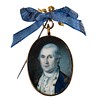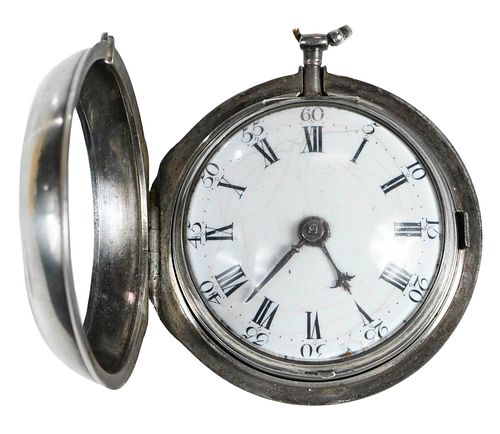Rare Philadelphia Colonial Coin Silver Pocket Watch
Bid Increments
| Price | Bid Increment |
|---|---|
| $0 | $25 |
| $100 | $50 |
| $1,000 | $100 |
| $2,000 | $200 |
| $3,000 | $250 |
| $5,000 | $500 |
| $10,000 | $1,000 |
| $20,000 | $2,000 |
| $50,000 | $5,000 |
| $100,000 | $10,000 |
Pennsylvania, c. 1771-1777, coin silver double case, inner and outer cases with marks probably for Joseph Carman (Philadelphia, Pennsylvania, working 1771-1777), 42mm inner case, 49mm outer case, Roman and Arabic numeral hour marks, beetle and poker hands, verge fusee movement, movement engraved "Laure Birnie, Philad, No. 38", three watch papers: one without markings; one marked "506/Dec 4-1843"; one "A. McKinley,/Clock & Watch Maker,/Washington Pa."
Note: Laurence Birnie was a watchmaker who had emigrated to America from Ballymoney, Ireland in 1774, with only a brief stopover in England. At age 22, he set up shop on Philadelphia?s Second Street, in the same trade for which he apprenticed under his father and brothers, ?making and repairing all sorts of repeating, horizontal and plain watches.?
Historically important is that Birnie, finding himself at the primary intersection of Revolutionary conflict, chose to align himself with the American cause, fashioning files that were crucial in the manufacture of lockworks on firearms, a skill that no doubt came naturally to the steady handed watchmaker.
By 1776 Birnie had become the captain of a Philadelphia militia company. Under his service was a young artist named Charles Willson Peale at the rank of lieutenant. Peale went on to assume the role of captain from Birnie, who was not well at the time, and in the winter of 1776 famously crossed the Delaware River with General Washington?s army in what Peale described as ?the most hellish scene I have ever beheld.?
There exists, from around this same time, a portrait miniature of Laurence Birnie by the hand of Charles Willson Peale. It is obvious the admiration Birnie commanded from his men who served with him.
In the subsequent years, Birnie unceremoniously returned to Ireland to settle outstanding debts on his family?s land. That examples of Birnie?s work remain with us to this day from such a tumultuous time in our nation?s infancy is a testament to their lasting importance.
Loomes, Brian, and G. H. Baillie. Watchmakers and Clockmakers of the World. London: Robert Hale, 2006.
Illustrated and discussed: Antique Week, "Colonial watch causing a stir among historians", by Eric C. Rodenberg, September 17, 2012 (with copy).
Watch & Clock Bulletin, "Laurence Birnie An Antrim Clockmaker" by Killian Robinson and Bruce Forman, November/December 2015 (with copy).
Provenance: Private Collection, New York State
Condition
no key, not wound/hands not moving/keeping time when inspected, plastic crystal with scratches, broken bow, cracks to dial and chip between 5 and 6 o'clock- also with other small chips around edge, dents, lead solder repairs to inside of both cases, heavy tarnish, release button on outer case mostly missing and hinge missing a part, tab on inner case broken and hinge with brass replacement parts, outer case with internal cracks, heavily scratched and stickers on back
Purchased items will be available for pick up or shipping from our Asheville, North Carolina auction facility within ten business days of the auction will be assessed a storage fee of $5.00 per day, per item. Purchaser agrees that packing and shipping is done at the purchaser's risk and that the purchaser will pay in advance all packing expenses, materials, carrier fees and insurance charges. At our discretion, items will either be packed by an agent such as a packaging store or Brunk Auctions. Please allow two weeks for shipping after payment is received. Shipment of large items is the responsibility of the purchaser. We are happy to provide names of carriers and shippers if a purchaser so requests. Brunk Auctions will have no liability for any loss or damage to shipped items.





































